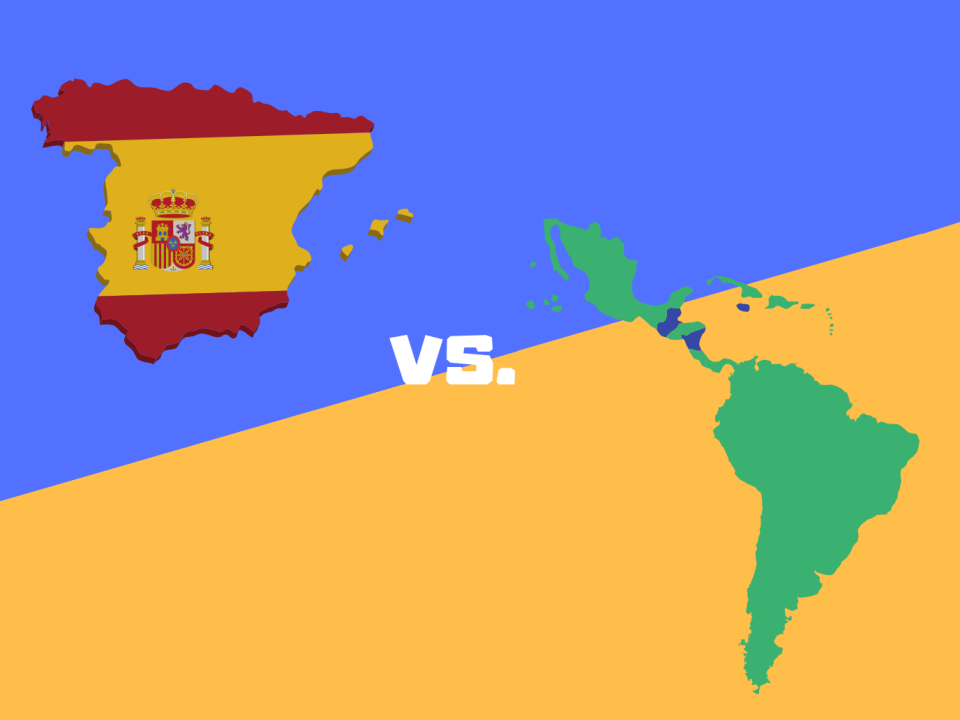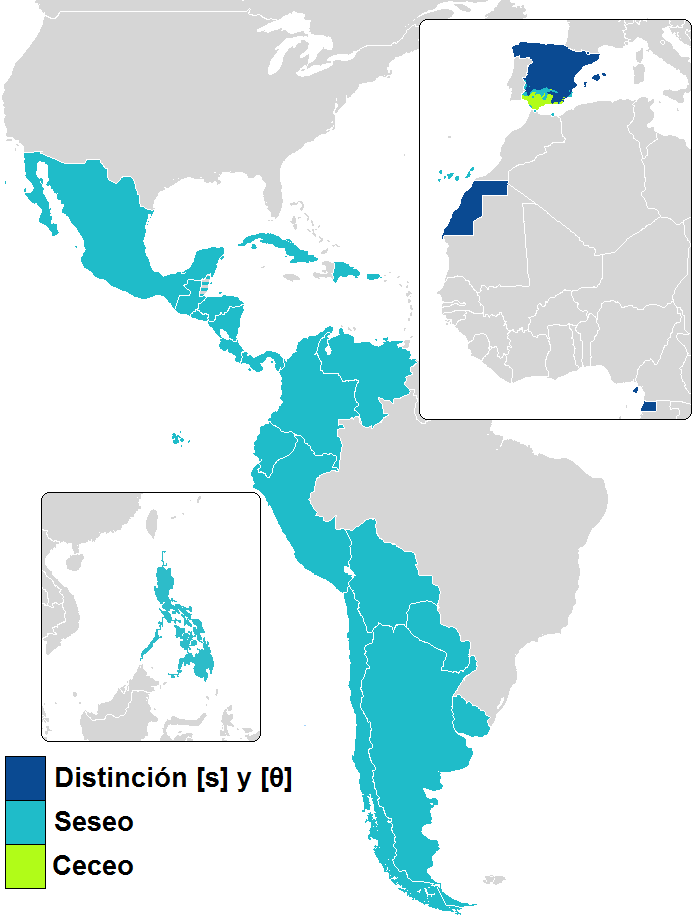Spanish speakers from across Spain and Latin America can understand each other perfectly, but there are notable differences in accents, vocabulary, and expressions.

In this article, we'll cover the 10 key differences between Spanish from Spain and Latin American Spanish.
We'll begin with probably the biggest difference.
Which is this: the word used to refer to "Spain" Spanish is actually different from Latin American Spanish.
Speakeasy BCN is a leading Spanish language school in Barcelona. We often find that international students from the United States ask whether learning Spanish in Barcelona will affect them – the short answer is "no"! A Spanish speaker from Spain will be perfectly understood in Latin America, and vice versa.
But for the longer answer, keep reading...
1. Castellano vs Español
The name of the Spanish language changes depending on where you are.
Español: Used in Latin America
Castellano: Used in Spain
In Latin America, the Spanish language is typically called español (Spanish). This reflects its origins, as the language was brought over from Spain during colonization. In Spain, however, the language is often referred to as castellano (Castilian). This name highlights its roots in the Castile region of central Spain, where the language is understood to have originated.
Spaniards avoid calling the language español because there are other languages spoken within Spain that are also considered "Spanish languages" (lenguas españolas). These include Catalan, Valencian, Galician, and Basque, which hold official status in their respective regions.
2. Pronunciation
In this section we cover the 3 major differences in pronunciation between Spanish from Spain, and Spanish from Latin America.
The TH sound in Spanish from Spain
One of the most noticeable differences between Spanish in Spain and Latin America is the pronunciation of the letters Z and soft C (before I or E).
In Spain, these letters are pronounced with a "TH" sound. This is why someone from Barcelona would say Barthelona. In Latin America, however, these letters are pronounced as S, a practice called seseo.
Example sentence: La taza es azul
Spain: La ta[th]a es a[th]ul
Latin America: La ta[s]a es a[s]ul
It's worth noting there are parts of southern Andalusia in Spain and the Canary Islands where native Spanish speakers will use the seseo.
In contrast, the ceceo is another pronunciation phenomenon found in some areas of Andalusia. Speakers who use the ceceo pronounce both the s and the z (or soft c) with a "th" sound, making no distinction between the two. For example, casa (house) and caza (hunt) would both be pronounced as catha.

The SH sound in Argentina
In most Spanish-speaking countries, the double LL and the letter Y are pronounced with a "Y" sound, like in English. However, in parts of Argentina and Uruguay, these letters are pronounced with a "SH" sound.
This feature is known as yeísmo rehilado.
Example sentence: Está lloviendo en la playa
Argentina/Uruguay: Está [sh]oviendo en la pla[sh]a
Elsewhere: Está [y]oviendo en la pla[y]a
This distinct pronunciation is a hallmark of the Rioplatense accent, making it immediately recognizable.
Dropping of the S sounds
In many Latin American accents, especially in the Caribbean and coastal regions, the S at the end of words or syllables is often aspirated or dropped altogether.
This aspiration is also true for accents within Spain in the southern region of Andalusia as well as the Canary Islands.
Example sentence: Estás aquí
Caribbean, Andalusian and Canarian Spanish accents: Eh-táh aquí (the S is aspirated or dropped).
Elsewhere: Es-tás aquí (the S is fully pronounced).
Example sentence: Las cosas
Caribbean, Andalusian and Canarian Spanish accents: Las cosah
Elsewhere: Las cosas
The linguistic term for the dropping or weakening of the S sound is called “aspiration” or “elision”.
Aspiration refers to the softening of the S sound, where it’s pronounced as an audible breathy h sound. Elision refers to the complete omission of the S sound, where it disappears altogether.
The softer J sound
Another notable pronunciation difference is the way the letter J is pronounced. In Spain, the J is pronounced with a harsher, throatier sound, similar to the German ch in Bach. In most Latin American accents, however, the J is much softer, and closer to the English H sound, giving it a smoother and less abrasive quality.
This softer pronunciation reflects the broader trend of less guttural sounds in Latin American Spanish.
In Spanish from Spain, this guttural sound also applies to words where the letter G is followed by an e or an i. Like the G in Jorge or Gibraltar.
3. Formal vs informal 'you’
Depending on whether you're in Spain or Latin America, the word for "you" changes based on formality and regional preferences.
Usted: Used across Latin America for both formal and informal situations, even among family members.
Tú: Common in both Spain and Latin America for informal situations, though less common in formal contexts in Latin America.
In Spanish, usted is the formal equivalent of tú. While usted is rarely used in Spain—reserved for addressing elders, authority figures, or in highly formal settings like speaking to royalty—it’s much more common in Latin America. There, usted is often used as a default, and referring to someone as tú inappropriately might be considered impolite or even vulgar.
In many cases, parents will even address their children with usted.
Conjugation
The usted form uses conjugations similar to third-person pronouns like él or ella.
This is a key grammatical difference when compared to tú.
Example sentence (singular): You speak Spanish
Spain (informal): Tú hablas español
Latin America (formal): Usted habla español
Example sentence (plural): You are all learning
Spain (informal): Vosotros estáis aprendiendo
Latin America (universal): Ustedes están aprendiendo
In Spain, vosotros (the plural informal "you") is used in casual contexts, like speaking with friends, while ustedes is reserved only for formality. In Latin America and the Canary Islands of Spain, vosotros is not used, and ustedes is used universally, regardless of formality.
Vos vs tú
In parts of Colombia, Argentina, and Uruguay, vos is used instead of tú for informal situations. Unlike usted, vos doesn’t share third-person conjugation but instead has its own unique forms.
Example sentence: You want to go
With tú: Tú quieres ir
With vos: Vos querés ir
Example sentence: You have a book
With tú: Tú tienes un libro
With vos: Vos tenés un libro
The use of vos is a hallmark of Rioplatense and other regional accents such as the Paisas region of Colombia.
4. Vocabulary
There are significant differences in vocabulary between Spanish from Spain and Spanish in Latin American countries.
These differences can range from everyday objects to verbs and even regional terms influenced by English or indigenous languages. Travelers or Spanish learners might find themselves caught off guard by these variations—even native Spanish speakers might be unfamiliar with some of the words from other Spanish-speaking countries!
In rare cases, an everyday word in Spanish from Spain can have vulgar and even offensive connotations in Latin American Spanish.
General vocabulary differences
Some words differ entirely between Spain and Latin America, even though they refer to the same objects or actions.
Here are a few common examples:
Car: Coche (Spain) vs. Carro or Auto (Latin America).
To drive: Conducir (Spain) vs. Manejar (Latin America).
Here: Aquí (Spain) vs. Acá (Latin America).
Handsome/Beautiful: Guapo/Guapa (Spain) vs. Lindo/Linda (Latin America).
Cell phone: Móvil (Spain) vs. Celular (Latin America).
Bus: Autobús (Spain) vs. Camión or Colectivo (Latin America).
Room: Habitación (Spain) vs. Cuarto (Latin America).
Glasses (eyewear): Gafas (Spain) vs. Lentes (Latin America).
To catch/grab: Coger (Spain) vs. Agarrar (Latin America). (NOTE: In Latin America, coger can have vulgar connotations.)
Loanwords from English
Latin American Spanish has absorbed many loanwords from English, especially in countries with close ties to the United States. These terms are often modern and relate to technology, business, or pop culture.
In Spain, equivalent terms are often derived from traditional Spanish roots.
Computer: Ordenador (Spain) vs. Computadora (Latin America).
Truck: Camión (Spain) vs. Troca (Latin America, influenced by "truck").
Computer mouse: Ratón (Spain) vs. Mouse (Latin America, even though it’s an English loanword, it's widely adopted).
Parking lot: Aparcamiento (Spain) vs. Parqueadero (Latin America, influenced by "parking").
To rent: Alquilar (Spain) vs. Rentar (Latin America).
Loanwords from indigenous languages
Many Latin American countries have incorporated words from indigenous languages like Nahuatl, Quechua, and Guaraní, which are not commonly used in Spain. These terms often describe local foods, plants, or cultural items.
Examples are:
Avocado: Aguacate (Spain) vs. Palta (Latin America, Quechua origin).
Corn: Maíz (Spain) vs. Elote (Latin America, Nahuatl origin).
Potato: Patata (Spain) vs. Papa (Latin America, Quechua origin).
Tomato: Tomate (Spain) vs. Jitomate (Mexico, Nahuatl origin).
Bean: Judía (Spain) vs. Frijol (Latin America, Nahuatl origin).
5. Common phrases & slang
Idiomatic phrases often differ significantly between languages and even within regions of the same country. For example, in the United States, someone in the South might say, "Bless your heart," while someone in the North is more likely to say, "No worries." These differences highlight how culture shapes language.
When it comes to Spanish, the list of idiomatic phrases and slang that differ between Spain and Latin America is so extensive, we would need a separate article to cover it all!
Below, however, we’ve gathered 5 of the most common ones that you’re likely to hear in day-to-day life:
Money: Pasta (Spain) vs. Plata (Latin America).
Cool: Guay (Spain) vs. Chévere, Bacano/a, Padre, Copado (Latin America, depending on region).
Man/Dude: Tío (Spain) vs. Güey, Parce, Flaco, Pana, M’hijo, Papi (Latin America, depending on region).
Okay: Vale (Spain) vs. Órale, Listo, Dale, Okey, Ta’ bien (Latin America, depending on the region).
Alright: Venga (Spain) vs. Dale, Ándale, Hágale (Latin America, depending on the region).
6. Terms of endearment
Similar to idiomatic expressions and slang, there are significant differences in terms of endearment between Spanish from Spain and Latin America. These differences aren’t just about how lovers address each other—they also extend to how strangers interact in warm and expressive ways.
For example, in the UK, it’s common for people to refer affectionately (but in a non-romantic way) to strangers as my love or pet, while in the USA, terms like honey or sweetie might be used.
In Spanish-speaking cultures, terms of endearment are highly expressive and often used casually, even with strangers. It’s worth familiarizing yourself with these phrases to avoid thinking someone is romantically interested in you when they’re simply being friendly!
Ways Spanish people refer to their lovers
Gordi: A playful, affectionate term meaning "chubby," often used regardless of body type.
Cariño: A common and heartfelt term meaning "darling" or "dear."
Amor mío: Literally "my love," used romantically.
Mi vida: "My life," a very passionate term.
Cielo: "Heaven" or "my heaven."
Ways Latin American people refer to their lovers
Mi amor: "My love," widely used.
Mi vida: "My life," very romantic and affectionate.
Corazón: "Heart," a common term of endearment.
Mi cielo: "My heaven," romantic but also tender.
Precioso/a: "Precious," used romantically.
Flaco/Flaca: "Slim" or "skinny," often used affectionately in countries like Argentina.
Ways Spanish people refer to strangers
Guapo/Guapa: "Handsome/Beautiful," commonly used in Spain to address strangers in a warm, non-flirtatious way.
Cariño: "Dear" or "sweetheart," used casually.
Hijo/Hija: "Son/Daughter," often used affectionately toward younger people.
Cielo: "Heaven," used warmly for strangers.
Rey/Reina: "King/Queen," used casually.
Ways Latin American people refer to strangers
Mi amor: "My love," used warmly and casually.
Mi vida: "My life," an affectionate way to address someone.
Mi hijo/Mi hija: "My son/My daughter," used to address younger people or show warmth.
Reina/Rey: "Queen/King," used in some regions to flatter or show respect.
Linda/Lindo: "Beautiful," common and casual.
Corazón: "Heart," a warm way to address someone.
7. Diminutives
In Spanish, you can make a noun smaller or more endearing by adding a diminutive to the end of the word. This is similar to how in English, we might use words like little or tiny to describe something smaller or add -y or -ie to create affectionate nicknames (e.g., doggy, cutie).
Diminutives are widely used in Spanish for several reasons:
To express affection or endearment (e.g., abuelita instead of abuela to mean "grandma").
To make something sound less imposing or more casual (e.g., cafecito instead of café for "a little coffee").
To soften a statement or request, making it sound more polite (e.g., momentito instead of momento for "just a little moment").
In Spain, the most common diminutive endings are -ito/-ita and sometimes -illo/-illa. In Latin America, -ito/-ita is also widespread, but certain countries prefer regional variants like -ico/-ica.
Example sentence 2: Look at this tiny little thing!
Spain: ¡Mira esta cosilla! (Using -illo to emphasize smallness).
Latin American: ¡Mire esta cosita! (Using -ito).
Latin America (regional): ¡Mire esta cosita tan chiquitica! (Using -ito and -ico to add extra emphasis and affection).
In some Latin American countries, diminutives reflect indigenous language influences, adding unique regional flair. For example, in Mexico, you might hear -cito/-ecito endings influenced by Nahuatl.
Example sentence: Bring me the little water.
Spain: Tráeme el agüita.
Latin America (Mexico): Tráeme el agüecito.
8. Time & punctuality
There are important differences in how Spanish speakers in Spain and Latin America use words related to time.
Words like ahora and ahorita may appear similar but can imply very different lengths of time depending on the region. It's worth knowing this, in order to manage expectations when speaking Spanish in different parts of the world.
"Ahora"
In both Spain and Latin America, ahora generally means "now." However, in Spain, it’s more likely to mean right now or immediately, while in Latin America, it can sometimes mean in a little while or even "soon."
Example sentence: Voy ahora.
Spain: I’m going right now.
Latin America: I’ll go soon (not necessarily immediately).
"Ahorita"
The diminutive ahorita adds another layer of complexity. While it literally translates to "right now," in many Latin American countries, it often implies a vague or delayed sense of time, like "in a bit" or "eventually."
In Spain, ahorita is rarely used.
Example sentence: Ahorita voy.
Mexico: I’ll go in a little while (but not immediately).
Colombia: I’ll go soon (but it might not be urgent).
"Ya"
Another important word is ya, which means "already" or "now" but is also flexible.
In Spain, ya often implies immediacy: Ya lo hago means "I’m doing it now." In Latin America, ya can also mean soon or I’ll get to it: Ya lo hago might mean "I’ll do it soon."
Example sentence: Ya voy.
Spain: I’m on my way (immediate).
Latin America: I’ll leave soon (not always immediate).
9. Past tense
One of the key differences between Spanish from Spain and Spanish from Latin America lies in how the past tense is used.
In Spain, speakers commonly use the pretérito perfecto (present perfect) to talk about actions that have been completed recently or have relevance to the present. For example:
He comido ("I have eaten").
In Latin America, speakers tend to favor the pretérito simple (simple past) for the same context. For example:
Comí ("I ate").
This means that in a casual conversation, a Spaniard might say "¿Has visto esta película?" ("Have you seen this movie?"), while someone in Latin America would more likely say "¿Viste esta película?" ("Did you see this movie?").
Both forms are grammatically correct, but the preference reflects regional differences in how past actions are framed in relation to the present.
10. “Leísmo”
Leísmo is a linguistic phenomenon in Spanish where the pronoun "le" is used as a direct object instead of the standard "lo" or "la" when referring to a masculine singular person. In standard Spanish grammar, le is typically reserved for indirect objects (e.g., Le di el libro – "I gave him the book"), but in leísmo, le replaces lo when referring to a man in certain contexts.
For example:
Standard Spanish (Latin America): Lo vi ayer ("I saw him yesterday").
Leísmo (Spain): Le vi ayer ("I saw him yesterday").
Leísmo is most commonly found in central and northern Spain, particularly in Castile, which is why it’s often referred to as "Castilian leísmo." While it’s prevalent in Spain, it’s generally not used in Latin America, where standard grammar rules are more consistently followed, and lo is used as the masculine direct object pronoun.
Frequently asked questions (FAQ)
Difference between Latin and Spanish
Latin is an ancient language that originated in the Roman Empire and is the root of the Romance languages, including Spanish. Approximately 70% of Spanish vocabulary is derived from Latin, reflecting its historical development from Vulgar Latin.
Arabic words make up around 8% of Spanish reflecting the former conquest of the Iberian peninsula up until 1492.
While Latin is no longer spoken as a native language, Spanish has evolved into one of the most widely spoken languages in the world today.
Is Spanish from Spain?
The Spanish language developed from Vulgar Latin in the Castile region during the Middle Ages. Over time, it spread globally through Spain’s colonial expansion, becoming the primary language in Latin America and many other parts of the world.
Posted in Culture, Learn Spanish
Learn and improve your Spanish in Barcelona, one of the world's most vibrant and exciting cities.
Here at Speakeasy BCN you'll find courses for all abilities and timetables, an incredible team of talented and motivated teachers and classmates to share your interests and passions. And if you need a visa for your stay, then of course we're able to help and advise.

Start your learning Spanish in Barcelona adventure
Let us know if you have any questions about our courses, our school and life at Speakeasy.